Study on the Rheological Properties of Fly Ash Modified Asphalt Mastics
Abstract
1. Introduction
2. Materials and Methods
2.1. Raw Materials
2.1.1. Base Asphalt
2.1.2. Fly Ash
2.1.3. Mineral Powder
2.2. Composition and Preparation of Asphalt Mastic
2.3. Test Methods
2.3.1. Scanning Electron Microscope (SEM)
2.3.2. X-ray Diffraction Test (XRD)
2.3.3. Dynamic Shear Rheology (DSR) Test
3. Results and Discussion
3.1. SEM
3.2. XRD
3.3. Rheological Performance Results of Asphalt Mastic
3.3.1. Temperature Sweep Test (TS)
3.3.2. Multi-Stress Creep Recovery (MSCR) Test
3.3.3. Frequency Scan (FS)
3.4. The Comparison of Asphalt Mastics’ Characteristics
4. Conclusions
- (1)
- Mineral powder particles presented more cubic shapes with more obvious surface angularity, while fly ash particles were close to spherical. The particle size of mineral powder was larger, and its surface was smooth and dense. Compared with mineral powder, the particle size of fly ash was relatively small, and its surface was fluffy. Some particles had pores. The fluffy surface of fly ash adsorbed asphalt more easily than the smooth and dense surface of mineral powder, forming an interlocking interface structure with the asphalt, thereby forming a stronger interaction ability with the asphalt.
- (2)
- The XRD test results of fly ash show that a wide diffraction peak appeared in the range of 16–35°, indicating the presence of glass bodies in fly ash. As an amorphous phase with lattice defects, the glass bodies had strong chemical activity, which made fly ash more active than mineral powder.
- (3)
- Compared with mineral powder, fly ash as a filler improved the high-temperature stability of asphalt mastic, but the improvement was not significant. The phase angle of the mineral powder asphalt mastic was higher than that of the fly ash asphalt mastic, indicating that fly ash had a negative impact on the elastic properties and low-temperature crack resistance of the asphalt mastic.
Author Contributions
Funding
Institutional Review Board Statement
Informed Consent Statement
Data Availability Statement
Conflicts of Interest
References
- Tianren, L. Mineralogy Research and Genesis Analysis of Fly Ash. Shanghai Geol. 1983, 3, 59–68. [Google Scholar]
- Mansor, S.; Haron, S.; Joohari, M.; Razali, M.; Ramli, R. The Effect of Utilizing Fly Ash and Bottom Ash as a Replacement of Mineral Filler in Porous Asphalt Mixtures. In Proceedings of the IOP Conference Series: Materials Science and Engineering, Sanya, China, 12–14 November 2021; p. 012086. [Google Scholar] [CrossRef]
- Zanjad, N.; Pawar, S.; Nayak, C. Use of fly ash cenosphere in the construction Industry: A review. Mater. Today Proc. 2022, 62, 2185–2190. [Google Scholar] [CrossRef]
- Fuyuan, W.; Zhengyan, W. Handbook on Utilization of Fly Ash; Butterworth-Heinemann: Oxford, UK, 2004; pp. 63–65. [Google Scholar]
- Bhatt, A.; Priyadarshini, S.; Mohanakrishnan, A.A.; Abri, A.; Sattler, M.; Techapaphawit, S. Physical, chemical, and geotechnical properties of coal fly ash: A global review. Case Stud. Constr. Mater. 2019, 11, e00263. [Google Scholar] [CrossRef]
- Nasir, N.H.M.; Usman, F.; Saggaf, A. Development of composite material from Recycled Polyethylene Terephthalate and fly ash: Four decades progress review. Curr. Res. Green Sustain. Chem. 2022, 5, 100280. [Google Scholar] [CrossRef]
- Norhaiza, G.; Khairunisa, M.; Saffuan, W.A. Utilization of Fly Ash in Construction. IOP Conf. Ser. Mater. Sci. Eng. 2019, 601, 012023. [Google Scholar] [CrossRef]
- Bieliatynskyi, A.; Yang, S.; Pershakov, V.; Shao, M.; Ta, M. The use of fiber made from fly ash from power plants in China in road and airfield construction. Constr. Build. Mater. 2022, 323, 126537. [Google Scholar] [CrossRef]
- Hudales, J. The use of MWI, fly ash in asphalt for road construction. In Studies in Environmental Science; Elsevier: Amsterdam, The Netherlands, 1994; Volume 60, pp. 227–232. [Google Scholar] [CrossRef]
- Mistry, R.; Roy, T.K. Effect of using fly ash as alternative filler in hot mix asphalt. Perspect. Sci. 2016, 8, 307–309. [Google Scholar] [CrossRef]
- Xie, J.; Wu, S.; Pang, L.; Lin, J.; Zhu, Z. Influence of surface treated fly ash with coupling agent on asphalt mixture moisture damage. Constr. Build. Mater. 2012, 30, 340–346. [Google Scholar] [CrossRef]
- Muhammad, J.; Peng, T.; Zhang, W.; Cheng, H.; Waqas, H.; Abdul, S.; Chen, K.; Zhou, Y. Moisture susceptibility and fatigue performance of asphalt binder modified by bone glue and coal fly ash. Constr. Build. Mater. 2021, 308, 125135. [Google Scholar] [CrossRef]
- Radwan, A.; Satar, M.; Hassan, N.; Rogo, K. The Influence of Coal Fly Ash on the Mechanical Properties of Hot Mix Asphalt Mixture. In IOP Conference Series: Earth and Environmental Science; IOP Publishing: Bristol, UK, 2022; p. 012012. [Google Scholar] [CrossRef]
- Likitlersuang, S.; Chompoorat, T. Laboratory investigation of the performances of cement and fly ash modified asphalt concrete mixtures. Int. J. Pavement Res. Technol. 2016, 9, 337–344. [Google Scholar] [CrossRef]
- Yıldız, K.; Atakan, M. Improving microwave healing characteristic of asphalt concrete by using fly ash as a filler. Constr. Build. Mater. 2020, 262, 120448. [Google Scholar] [CrossRef]
- Woszuk, A.; Bandura, L.; Franus, W. Fly ash as low cost and environmentally friendly filler and its effect on the properties of mix asphalt. J. Clean. Prod. 2019, 235, 493–502. [Google Scholar] [CrossRef]
- Chaira; Veranita. The Effect of Combining Coal Fly Ash and Lokan Shells as Filler Towards the Mixture of Asphalt Concrete Wearing Course. In Journal of Physics: Conference Series; IOP Publishing: Bristol, UK, 2020; p. 012033. [Google Scholar] [CrossRef]
- Mistry, R.; Roy, T.K. Performance evaluation of bituminous mix and mastic containing rice husk ash and fly ash as filler. Constr. Build. Mater. 2021, 268, 121187. [Google Scholar] [CrossRef]
- Amoni, B.C.; Freitas, A.D.L.; Bessa, R.A.; Oliveira, C.P.; Bastos-Neto, M.; Azevedo, D.C.S.; Lucena, S.M.P.; Sasaki, J.M.; Soares, J.B.; Soares, S.A.; et al. Effect of coal fly ash treatments on synthesis of high-quality zeolite A as a potential additive for warm mix asphalt. Mater. Chem. Phys. 2022, 275, 125197. [Google Scholar] [CrossRef]
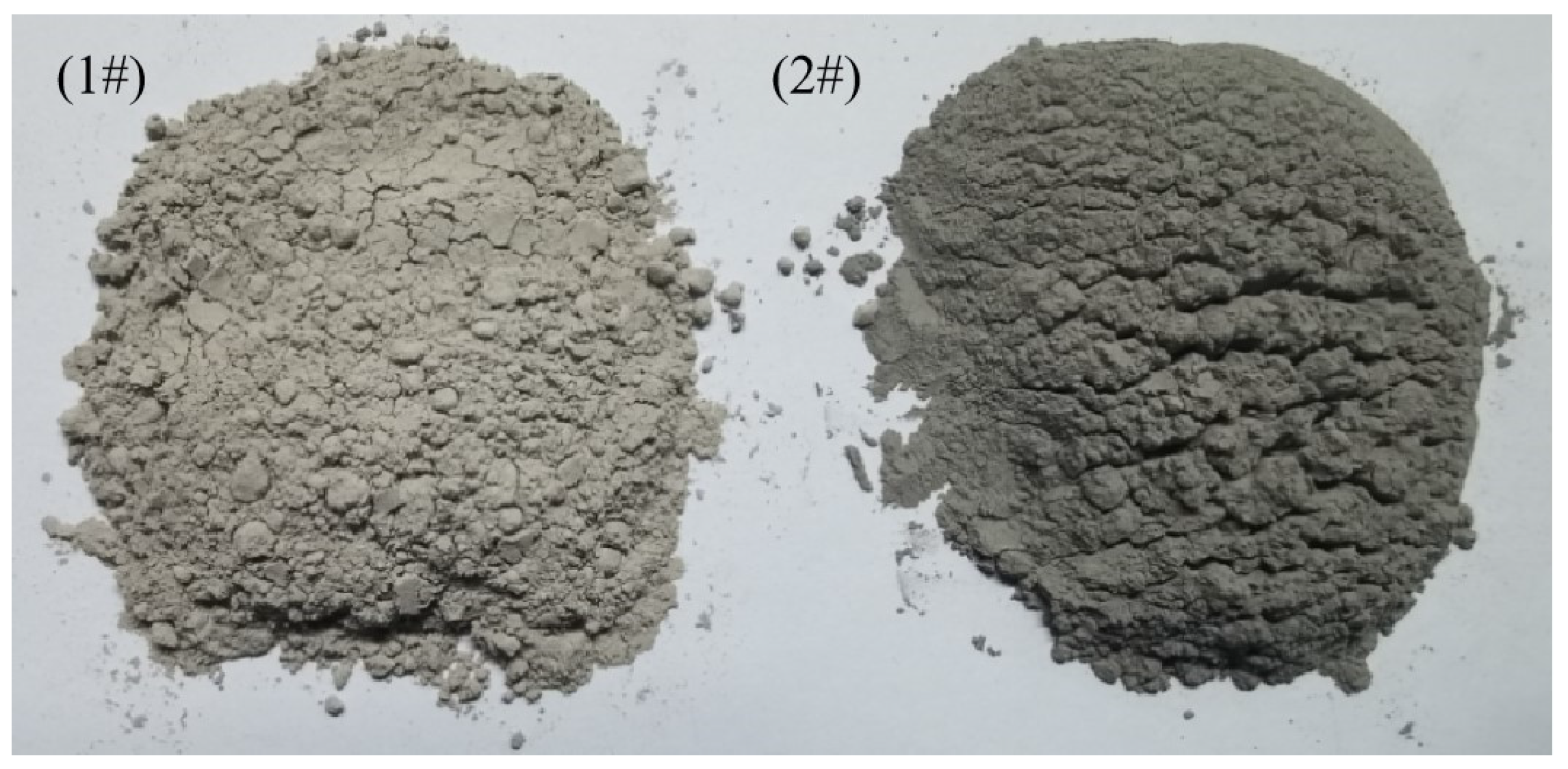
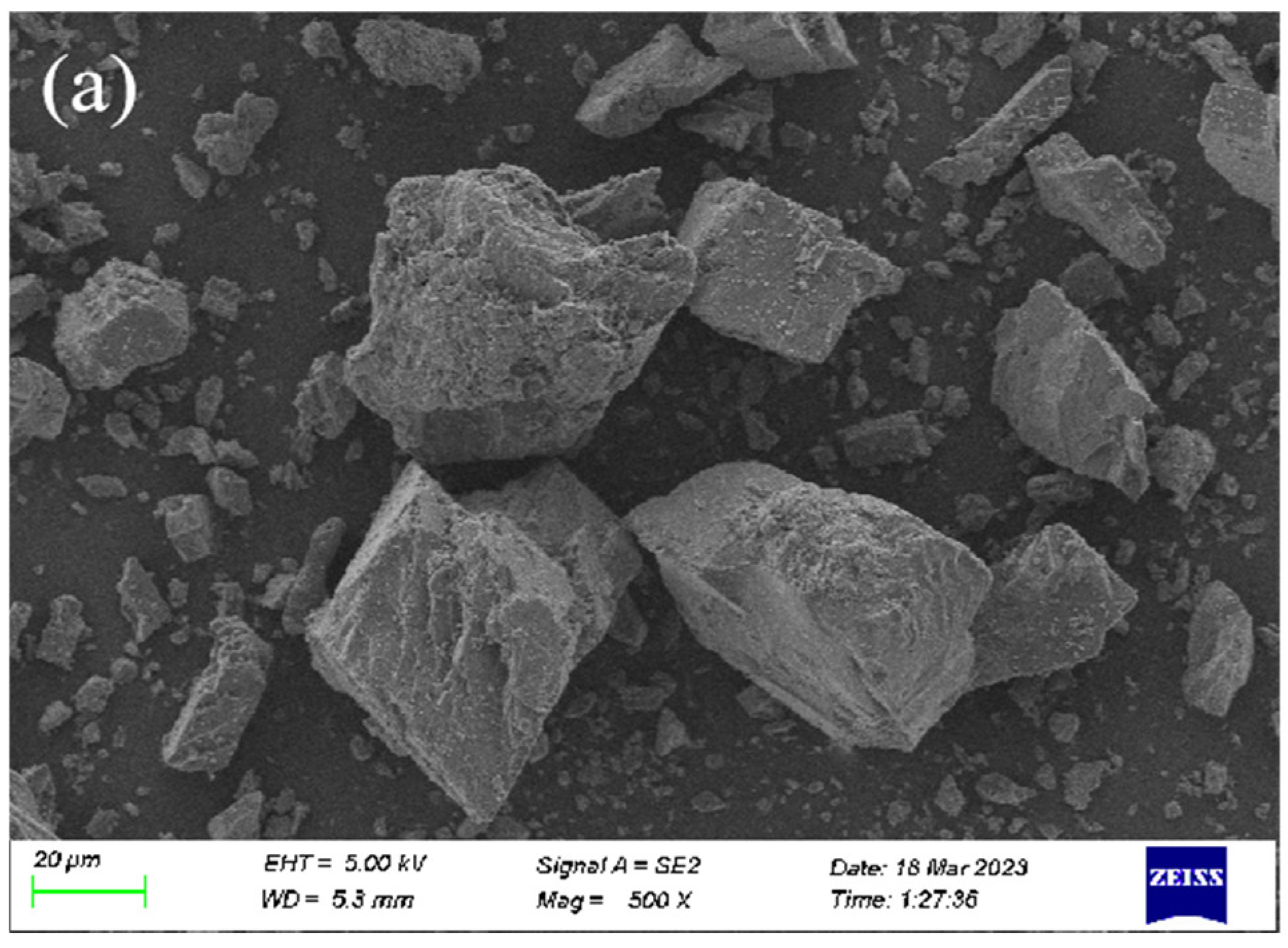
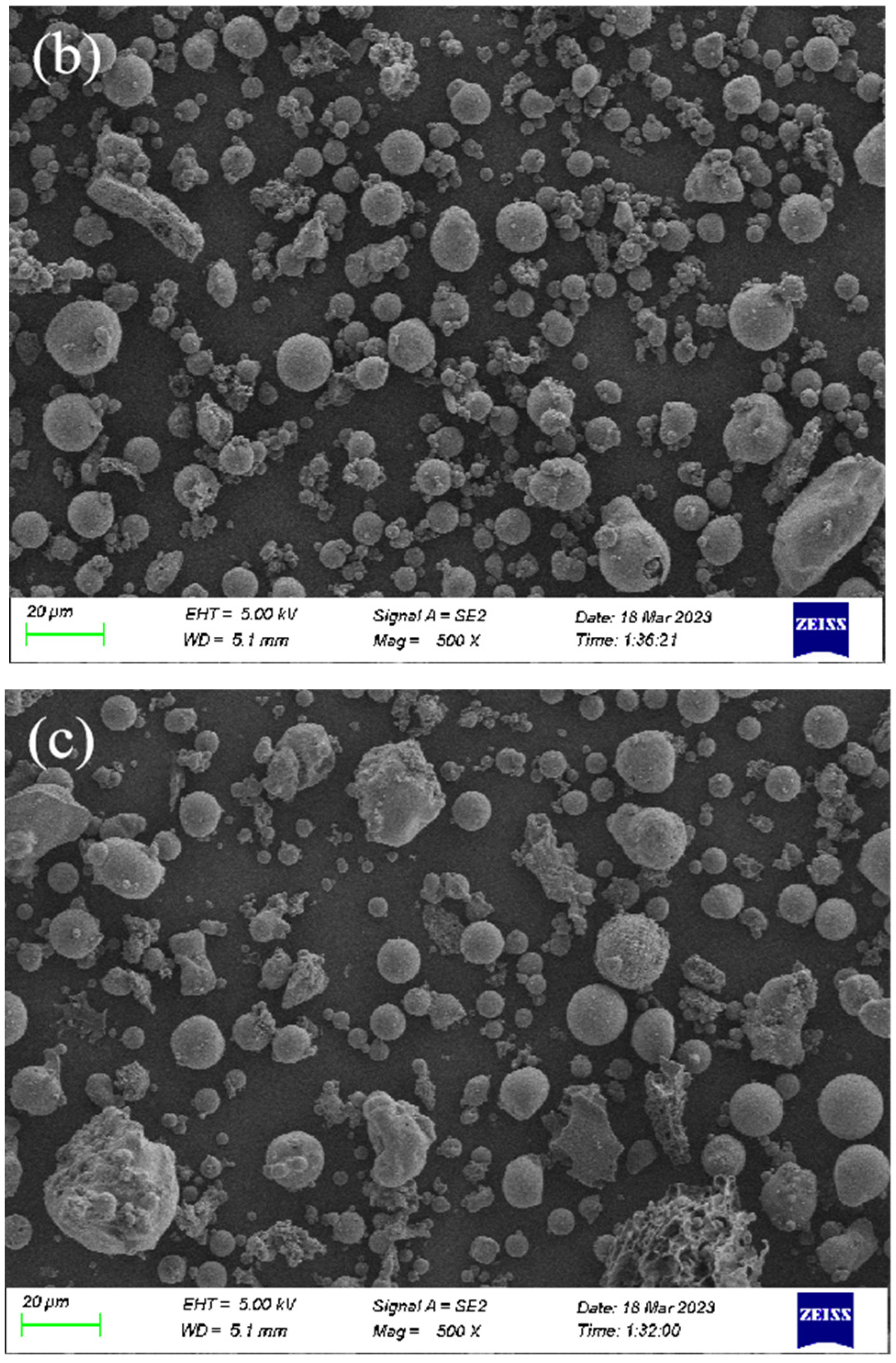
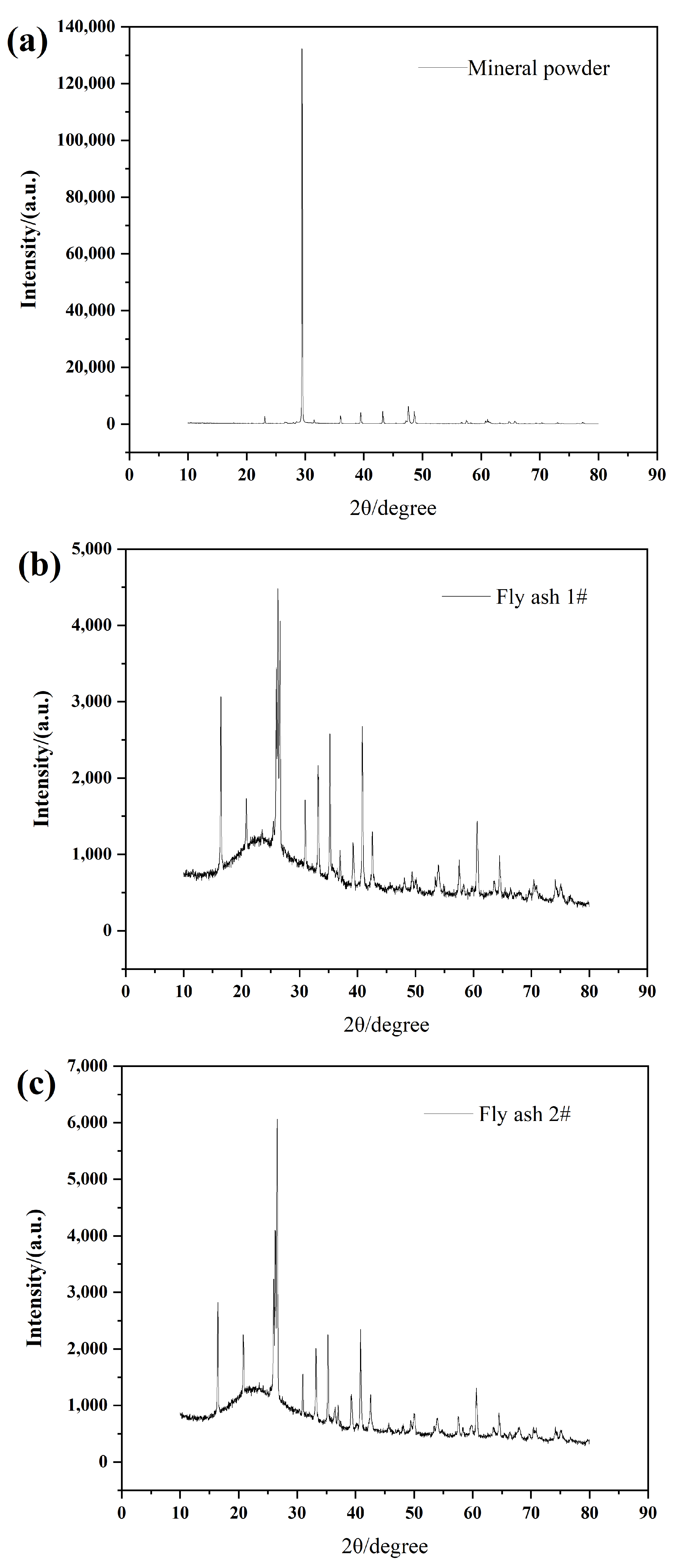
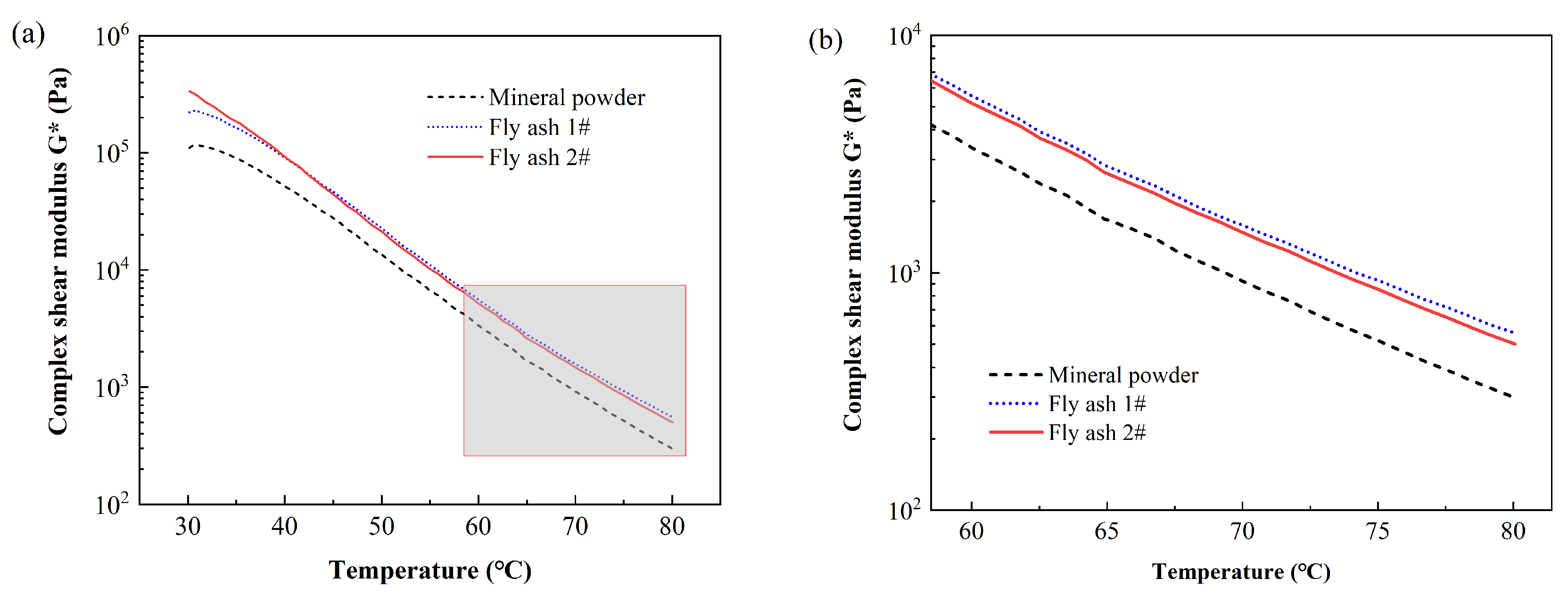

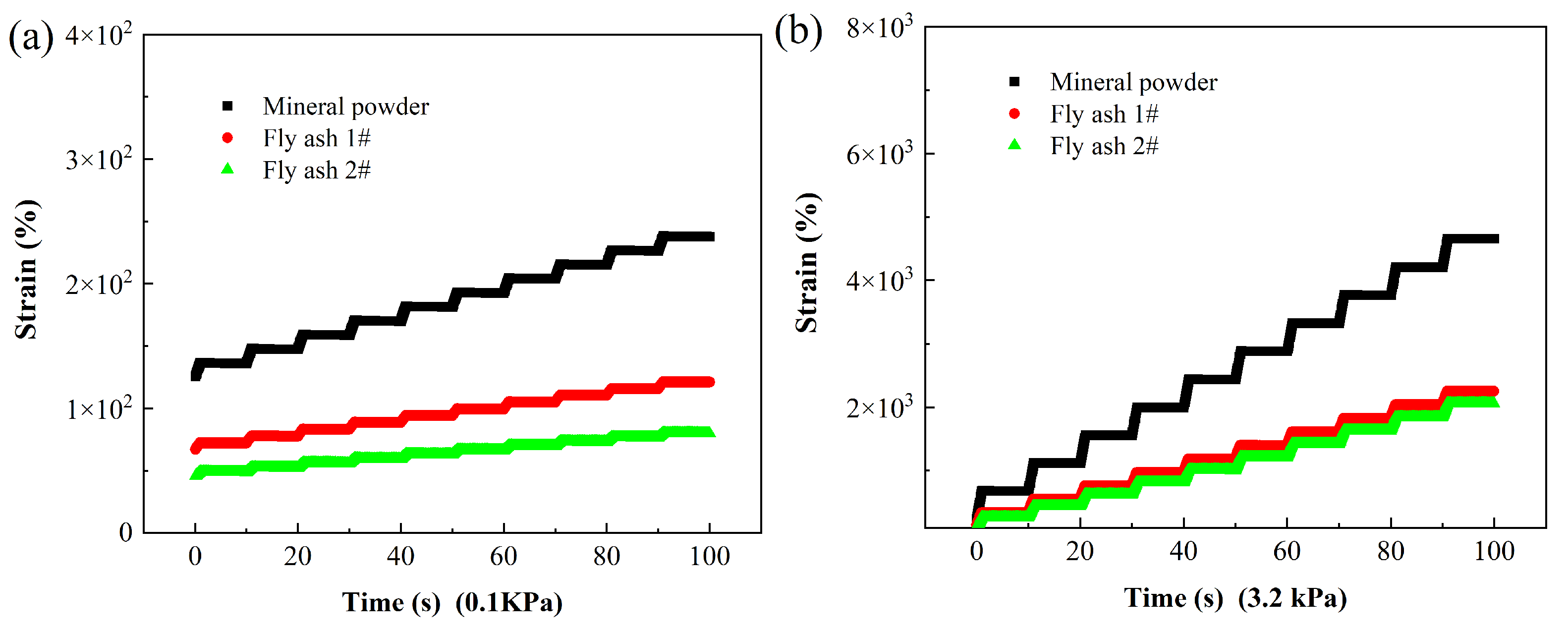
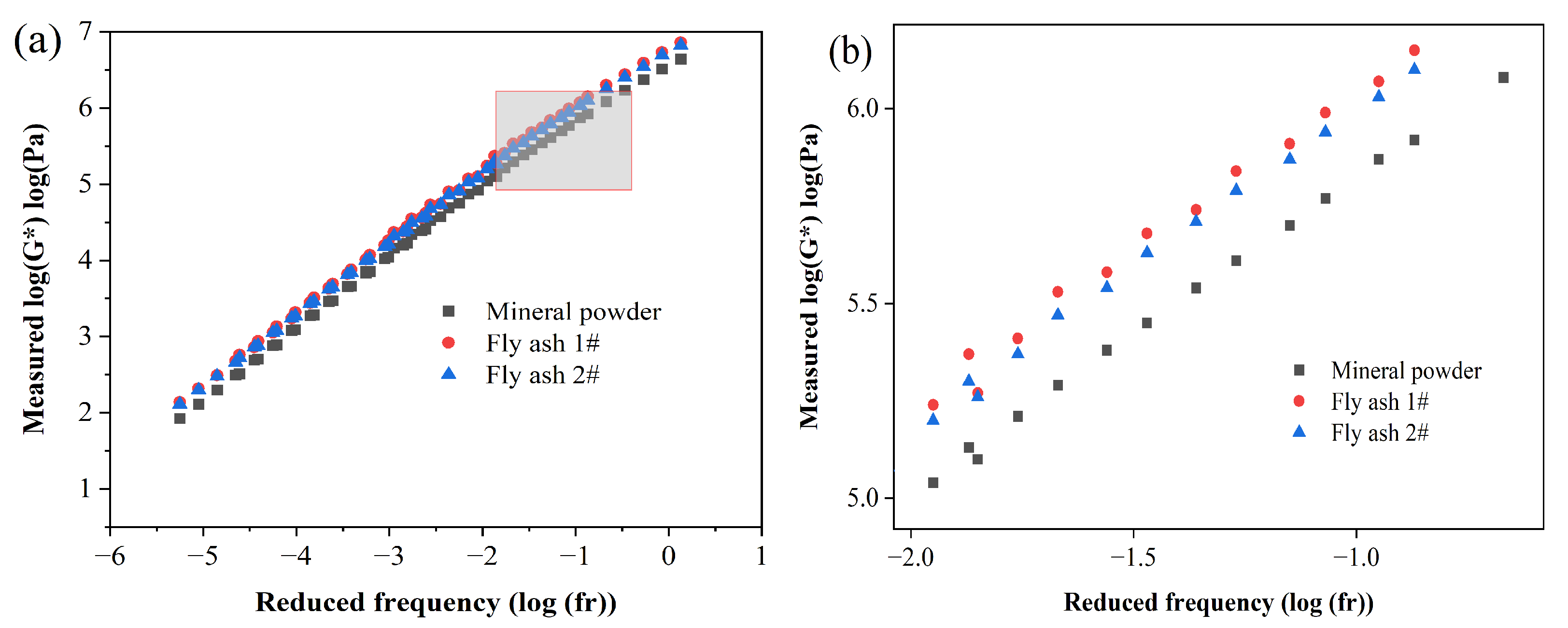
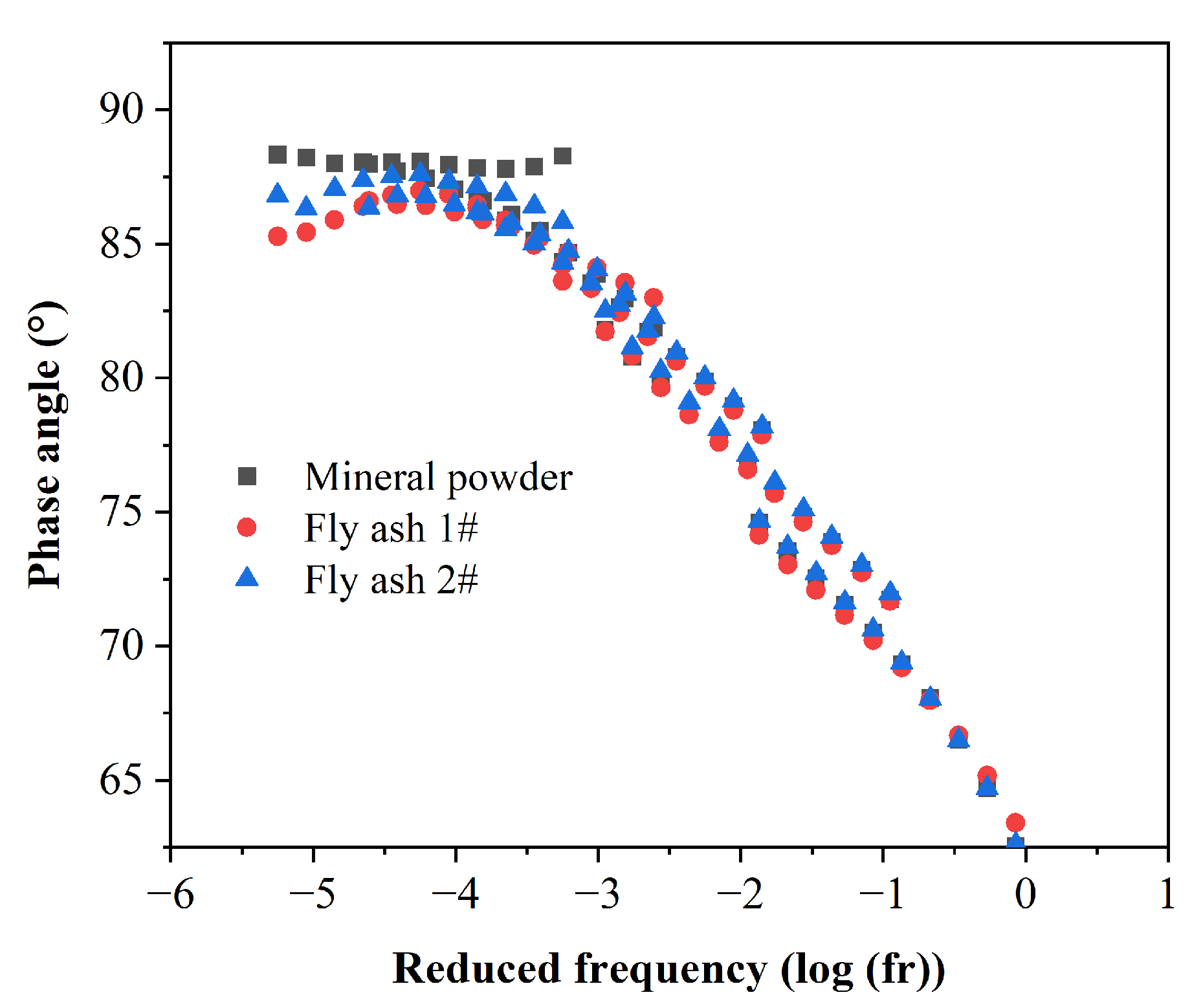
| Test Item | Requirement | Test Result | Test Method |
|---|---|---|---|
| Penetration (25 °C; 5 s; 100 g), 0.1 mm | 60–80 | 67 | T 0604-2011 |
| Softening point (R&B), °C | ≥46 | 48 | T 0606-2011 |
| 60 °C dynamic viscosity, Pa. s | ≥180 | 231 | T 0620-2000 |
| Ductility (10 °C), cm | ≥15 | 24 | T 0605-2011 |
| After TFOT | Requirement | Test Result | Test Method |
| Mass change, % | ±0.8 | −0.059 | T 0609-2011 |
| Residual penetration ratio, % | ≥61 | 64.5 | T 0604-2011 |
| Residual ductility (10 °C), cm | ≥6 | 6.4 | T 0605-2011 |
| Test Item | Mineral Powder | Fly Ash 1# | Fly Ash 2# |
|---|---|---|---|
| Apparent density (g/cm3) | 2.785 | 2.373 | 2.416 |
| Hydrophilicity coefficient | 0.687 | 0.612 | 0.633 |
| Stability | No discoloration | No discoloration | No discoloration |
| Filler Type | 0.1 kPa | 3.2 kPa | ||
|---|---|---|---|---|
| R/% | Jnr/kPa−1 | R/% | Jnr/kPa−1 | |
| Mineral powder | 11.66 | 0.63 | 0.67 | 1.21 |
| Fly ash 1# | 5.12 | 0.79 | 0.50 | 0.99 |
| Fly ash 2# | 4.85 | 0.70 | 0.49 | 0.89 |
| Filler Type | Microscopic Characteristics | Rheological Properties | |||
|---|---|---|---|---|---|
| SEM | XRD | TS | MSCR | FS | |
| Mineral powder | Cube-shaped, smooth, and dense surface | Main crystal form: calcite | The values of G* of mineral powder were slightly lower | At 0.1 kPa, the R value was higher, indicating better deformation recovery rate | The phase angle was higher, indicating good elasticity and low-temperature crack resistance |
| Fly ash 1# | Spherical and fluffy surface | Main crystal forms: quartz and mullite Presence of glass bodies | The values of G* and phase angles were similar | At 3.2 kPa, the Jnr values were lower, indicating better high-temperature creep performance | The G* values were slightly higher, indicating better high-temperature performance |
| Fly ash 2# | |||||
Disclaimer/Publisher’s Note: The statements, opinions and data contained in all publications are solely those of the individual author(s) and contributor(s) and not of MDPI and/or the editor(s). MDPI and/or the editor(s) disclaim responsibility for any injury to people or property resulting from any ideas, methods, instructions or products referred to in the content. |
© 2023 by the authors. Licensee MDPI, Basel, Switzerland. This article is an open access article distributed under the terms and conditions of the Creative Commons Attribution (CC BY) license (https://creativecommons.org/licenses/by/4.0/).
Share and Cite
Xing, X.; Han, K.; Liu, R.; Chen, Z.; Li, H.; Li, P.; Zhou, Q.; Wen, Y. Study on the Rheological Properties of Fly Ash Modified Asphalt Mastics. Coatings 2023, 13, 1307. https://doi.org/10.3390/coatings13081307
Xing X, Han K, Liu R, Chen Z, Li H, Li P, Zhou Q, Wen Y. Study on the Rheological Properties of Fly Ash Modified Asphalt Mastics. Coatings. 2023; 13(8):1307. https://doi.org/10.3390/coatings13081307
Chicago/Turabian StyleXing, Xiangyang, Kangxin Han, Ruijie Liu, Zijie Chen, Huilin Li, Ping Li, Qingyue Zhou, and Yong Wen. 2023. "Study on the Rheological Properties of Fly Ash Modified Asphalt Mastics" Coatings 13, no. 8: 1307. https://doi.org/10.3390/coatings13081307
APA StyleXing, X., Han, K., Liu, R., Chen, Z., Li, H., Li, P., Zhou, Q., & Wen, Y. (2023). Study on the Rheological Properties of Fly Ash Modified Asphalt Mastics. Coatings, 13(8), 1307. https://doi.org/10.3390/coatings13081307






